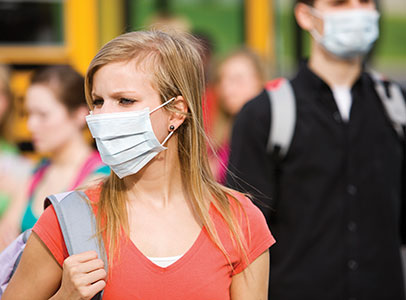
We are publishing this Mathematics Matters case study from 2010 as an illustration of how mathematical modelling has helped to protect society against epidemic diseases by informing public policy. It does not describe the current COVID-19 outbreak, although we hope and believe that mathematics will make an equally valuable contribution in the current crisis.
– IMA website editors
Despite the many advances of modern medicine, the world still suffers from frequent epidemics. In the past decade alone, the UK has been hit by a number of major outbreaks, such as the swine flu epidemic in 2009 and the foot and mouth epidemics in 2001 and 2007. All three events were dealt with through nationwide action, supported behind the scenes by mathematicians and epidemiologists working to understand the spread of infection and mitigate its effects.
In any epidemic situation, it is essential that healthcare providers react swiftly. When the swine flu outbreak began in spring 2009, epidemiologists and mathematicians such as John Edmunds, Ellen Brooks-Pollock and Ken Eames at the London School of Hygiene and Tropical Medicine, alongside other groups at the Health Protection Agency, Warwick University, and Imperial College London put a three-phase plan into action, with mathematics involved at every stage.
The first phase involved using data from Mexico (the source of the outbreak) to build up an initial mathematical model of the disease. While there are existing models of flu epidemics, each flu strain behaves slightly differently, so this phase was used to give an early estimate of the key parameters involved in the epidemic model. These include the number of new infections generated each day by an individual infection and the length of time between subsequent infections, called the generation time.
The second phase occurred when the virus hit the UK, with in-depth investigation into the first few hundred cases of infection led by the Health Protection Agency. The aim was to confirm each case with a viral swab, then trace infected patients and the people they had been in contact with in an effort to work out how they had become infected. This is only feasible when there are low numbers of infected patients, as it is unlikely that people will have met more than one infectious person in the early stages of an epidemic.
Understanding how diseases are transmitted through social contact is fundamental to modelling the course of an epidemic, so Edmunds and his team seized the opportunity to learn about peoples’ behaviour during the epidemic. They set up an online flu surveillance system (www.flusurvey.org.uk) to gather data on peoples’ symptoms and their social contacts. The results showed that while there was no trend in adult contact behaviour, the number of contacts children had was correlated with the rate of infection. This helped to explain why infection levels fell during school holidays – children were making fewer contacts, so had less chance to catch and spread the disease.
This research tied in to the third phase, which began once the number of infections had become too large to track individually. Using data from a number of sources, such as hospitals and GPs, Edmunds and his colleagues were able to build up an overall view of the number of flu cases. Aggregating this data is not as simple as it might seem, because a patient displaying flu symptoms may not actually have flu – the diagnosis can only be confirmed with a swab test, which is only feasible to do on a small sample of patients during a full-blown epidemic. Lags in receiving data can also introduce problems, since flu typically has a generation time of just a few days and even short delays can result in missing a generation of infection, so the model must account for this effect.
Once the data in place, the model can be used to estimate the number of expected infections, and to explore various vaccination scenarios that help to inform healthcare policy. The Department of Health makes plans for a reasonable worst case scenario based on modelling projections, and two important parameters for this task are the clinical attack rate (CAR) and the case fatality rate (CFR). The former is the proportion of the population that becomes ill, while the latter is the proportion of those becoming ill who die; multiplying these values together gives an estimate of the overall number of deaths.
 At the start of the epidemic there was little information available about the new flu strain and how it would behave in the UK, so the CAR and CFR were estimated based on data from Mexico and from the behaviour of previous flu epidemics. Because of uncertainties in the data it was impossible at the start of the epidemic to rule out moderately high values for both the CAR and CFR. This led to the alarming potential death figures reported in the British media, but this scenario was unlikely to actually occur – it was an estimate of a worst-case, not a prediction. By refining their modelling as more data become available, epidemiologists were able to bring these estimates down, leading to more realistic health planning.
At the start of the epidemic there was little information available about the new flu strain and how it would behave in the UK, so the CAR and CFR were estimated based on data from Mexico and from the behaviour of previous flu epidemics. Because of uncertainties in the data it was impossible at the start of the epidemic to rule out moderately high values for both the CAR and CFR. This led to the alarming potential death figures reported in the British media, but this scenario was unlikely to actually occur – it was an estimate of a worst-case, not a prediction. By refining their modelling as more data become available, epidemiologists were able to bring these estimates down, leading to more realistic health planning.
Many of the techniques for modelling human diseases also apply to animal epidemics like foot and mouth or infections spread by animals such as tuberculosis, though there are some differences. When combating outbreaks in human populations there are only a few actions available, such as when and who to vaccinate. Animal populations can also be culled or have their movements restricted, so these additional options must also be included within the model.
The fast changing nature of an epidemic makes it essential that we have the capacity to react quickly, processing data from a range of sources into useful predictions that can inform healthcare policy. The UK is a global leader in epidemic response, and the modelling work done in this country is highly influential in forming policy worldwide. Though not as visible as our paramedics or fire-fighters, the UK’s epidemiologists and mathematicians are a vital emergency service for when epidemics strike.
Technical Supplement
Modelling swine flu
Many simple models of epidemics split the population into three groups: those who are susceptible to infection, those who have the disease and can infect others, and those who have recovered from the disease and are now immune. A set of three differential equations describes the relationship between each group, depending on two key parameters: the recovery rate and transmission rate. The first is approximately equal to the inverse of the generation time, while the second is more difficult to estimate as it depends on both social contact and the biological process of infection. A third parameter, the basic reproductive number, is calculated by dividing the transmission rate by the recovery rate to give the average number of new infections produced by the average infected person. An epidemic occurs if the number of susceptibles is larger than the inverse of the reproductive number.
More complex models split the population up further: into different age groups, different locations, or by including a latent group of people who have been infected but are not yet infectious. These additional complexities require more parameters to describe, for instance, how individuals of different ages interact with each other.
The key difficulty in an epidemic situation is gathering reliable data so that these parameters can be estimated. During the 2009 swine flu outbreak, Edmunds’ team used social contact data to split the population into adults and children, evaluating the model for interactions both within and between the two groups. They also used their research on contact differences between term time and school holidays to model a transmission rate that varies over time, reproducing the pattern seen during the epidemic in which two infection spikes occurred – one before and one after the school summer holidays.
References
Baguelin M, Hoek A. J., Jit M., Flasche S., White P. J., Edmunds W. J. (2010) Vaccination against pandemic influenza A/HINIv in England: a real-time economic evaluation. Vaccine, 28(12), 2370-84. DOI: 10.1016/j. vaccine.20I0.01.002
Brooks-Pollock, E. & Eames, K. T. D. (2011) Pigs didn’t fly, but swine flu. Mathematics Today, 47(1) pp36-40.
Eames, K. T. D., Tilston, N. L., White, P. J, Adams, E. & Edmunds, W. J. (2010) The impact of illness and the impact of school closure on social contact patterns. Health Technology Assessment, 14(34) 267-312. DOI: 10.3310/ htaI4340
Read, J. M, Eames, K. T. D. & Edmunds, W. J. (2008) Dynamic social networks and the implications for the spread of infectious disease. Journal of the Royal Society Interface, 5(26), 1001-1007. DOI: 10.I098/rsif.2008.00I3
Tilston, N. L., Eames, K. T. D., Paolotti, D., Ealden, T. & Edmunds, W. J. (2010) Internet-based surveillance of I nfluenza-like-illness in the UK during the 2009 HINI influenza pandemic. BMC Public Health, 10(I), 650. DOI: I0.I I86/I47I-2458-I0-650
EPSRC Grants
Reference: EP/H027270/I
Title: The interaction between host demography and tuberculosis transmission: disease dynamics, control and evolution.
Reference: GR/S9I925/0I
Title: Prediction & Optimal Control of Invading Epidemic Diseases
The IMA would like to thank Professor John Edmunds, Dr. Ellen Brooks-Pollock and Dr. Ken Eames, London School of Hygiene and Tropical Medicine for their help in the preparation of this document.




Thank you for publishing the original article of 2010. We are still in a critical stage of the pandemic and I am wondering if there is going to be some publication to explain the “scientific basis for the R-number which is quoted virtually every day on TV and in the press, and now the K number that has appeared today? Are mathematicians represented within the science panels? And who can explain why the UK has had such a disastrous infection and death rate when it is stated that the UK was leading in the field in 2010?